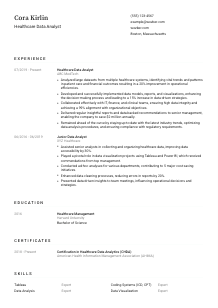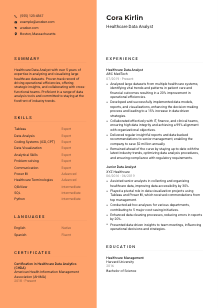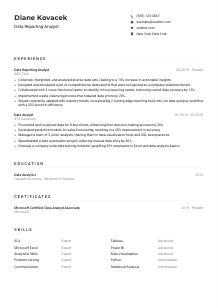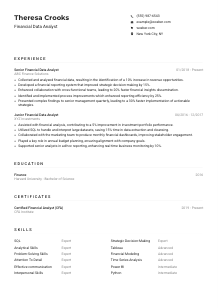Healthcare Data Analyst Resume Example
Decoding patient records, but your resume doesn't tally? Delve into this Healthcare Data Analyst resume example, synthesized with Wozber free resume builder. Grasp how to mesh your insights into health trends with job specifics, bringing your career prognosis as clear as an EKG line!

How to write a Healthcare Data Analyst resume?
Greetings, aspiring Healthcare Data Analyst! In the vast ocean of the job market, where every fish is bigger and brighter, your resume is the beacon that guides employers to your harbor. With Wozber's free resume builder, diving into creating an ATS-compliant resume tailored for your dream Healthcare Data Analyst role just got easier.
Are you ready to hook the big one? Let's navigate through the waves together and craft a resume that not only meets the mark but sets the bar!
Personal Details
The 'Personal Details' section might seem straightforward, but it's the compass that guides your resume. Let's plot a course to ensure it not only points true north but also captivates your future employer by aligning perfectly with what they seek for a Healthcare Data Analyst.
1. Your Name: The Anchor
Your name anchors your resume; it's the first detail that catches the employer's eye. Ensure it's prominently placed with a clean, professional font. This might seem like smooth sailing, but remember, the right presentation sets the tone for the journey ahead.
2. Job Title: Setting Sail
"Healthcare Data Analyst" – including the job title directly from the job description beneath your name immediately flags your resume as relevant. It's like hoisting your sails; it shows you're ready and equipped for the journey in this specific role.
3. Contact Information: Your Coordinates
Your phone number and email address are your coordinates on the map, ensuring the employer can find you easily. Double-check for accuracy; a mistyped digit can lead to missed connections. A professional email format (firstname.lastname@email.com) reinforces your professionalism.
4. Location: Charting Your Course
The job calls for being in Boston, Massachusetts. Mentioning your location confirms you're in the right port, making the hiring process smoother for both you and the employer. It's a small detail, but like a lighthouse, it guides decisions.
5. A Personal Website or LinkedIn Profile: Your Ship's Log
Adding a professional LinkedIn profile or a personal website is like adding a ship's log to your resume. It lets employers navigate through your professional journey on their terms, providing them with a deeper dive into your accomplishments.
Takeaway
Just like every ship needs a captain, your resume needs you. Take the helm in the Personal Details section, steering it with precision and foresight. Remember, this is your first impression; make it professional, aligned with the role, and ready to set sail.





Experience
In the bustling trade routes of Healthcare Data Analysis, your 'Experience' section is your treasure map. It's here you showcase the voyages you've undertaken and the treasures you've discovered along the way, aligning your past conquests with the requirements of your future expedition.
- Analyzed large datasets from multiple healthcare systems, identifying vital trends and patterns in patient care and financial outcomes resulting in a 20% improvement in operational efficiencies.
- Developed and successfully implemented data models, reports, and visualizations, enhancing the decision‑making process and leading to a 15% increase in data‑driven strategies.
- Collaborated effectively with IT, finance, and clinical teams, ensuring high data integrity and achieving a 99% alignment with organizational objectives.
- Delivered regular insightful reports and data‑backed recommendations to senior management, enabling the company to save $2 million annually.
- Remained ahead of the curve by staying up‑to‑date with the latest industry trends, optimizing data analysis procedures, and ensuring compliance with regulatory requirements.
- Assisted senior analysts in collecting and organizing healthcare data, improving data accessibility by 30%.
- Played a pivotal role in data visualization projects using Tableau and Power BI, which received commendations from top management.
- Conducted ad‑hoc analyses for various departments, contributing to 5 major cost‑saving initiatives.
- Enhanced data cleaning processes, reducing errors in reports by 20%.
- Presented data‑driven insights to team meetings, influencing operational decisions and strategies.
1. Decipher the Map
Begin by plotting a course, breaking down the job description into navigable points. For instance, "Analyzed large datasets from multiple healthcare systems" directly aligns with the given responsibilities of identifying trends and insights.
2. Log Your Voyages
Your roles and employers are the ports and islands you've visited. Present them starting with your most recent adventure. Each role is a chapter of your journey, outlining where you've been and what seas you've navigated.
3. Unearth the Treasures
Each job is a quest; for each position, describe the treasure you've discovered or the dragon you've defeated – in other words, the achievements that relate directly to the Healthcare Data Analyst role. Quantify your victories whenever possible.
4. Quantify Your Loot
"Identifying vital trends in patient care, resulting in a 20% improvement in operational efficiencies," showcases the value of your findings. Numbers and percentages are the gold coins of your treasure; they catch an employer's eye.
5. Navigate With Purpose
Keep your course steady and focused. Highlight the experiences that mirror the skills and responsibilities of the Healthcare Data Analyst role. Extraneous adventures, no matter how thrilling, may need to stay off this map if they don't lead to your treasure.
Takeaway
Your Experience section isn't just a list of places you've been; it's a compelling narrative of your professional journey. Weave your story with precision, ensuring each point showcases your suitability for the role, and watch as it leads you to new horizons.
Education
In the vast ocean of Healthcare Data Analytics, your 'Education' section is the compass that points to your foundational knowledge. It tells the tale of your academic voyages, reassuring employers that you're navigated by a true north of pertinent learning.
1. Identify Your North Star
Your first step is identifying the keystone of your educational journey, which, in this case, is a "Bachelor's degree in Healthcare Management, Business Analytics, Computer Science, Information Systems, or a related field." This aligns with the winds pushing towards the Healthcare Data Analyst role.
2. Chart Your Academic Course
Simplicity is key in detailing your academic voyages. List your degree, the field of study, the institution that charted your course, and the year you set sail (graduation year).
3. Align Your Studies
Choosing "Bachelor of Science in Healthcare Management" directly mirrors the desired qualifications for the role, showcasing that your academic vessel is well-equipped for the journey ahead.
4. Highlight Relevant Exploration
Certain roles may require detailing specific academic explorations - courses that have honed your skills directly for the role. While not always necessary, it's a beacon that guides employers to your specialized knowledge.
5. Append Other Scholarly Achievements
If your academic journey includes honors, relevant extracurriculars, or specific projects that underscore your fit for the Healthcare Data Analyst role, mention them. They're the embellishments on your compass, making it uniquely yours.
Takeaway
Your education section is more than dates and institutions; it's the map of your scholarly voyage. Make sure it aligns with the quadrant of your desired role, showing that you're navigated by the right stars. With every degree and course listed, you're a step closer to landing.
Certificates
In the world of Healthcare Data Analysis, certificates are the flags you hoist to show your specialized knowledge and continued growth in the field. They are badges of honor, signaling your commitment and expertise.
1. Chart the Requisites
Cast an eye over the horizon and identify the certificates the job prioritizes: 'Certification in Healthcare Data Analytics (CHDA) or Certified Professional in Healthcare Information and Management Systems (CPHIMS).' These are your guiding stars, directly aligning with the role's demands.
2. Fly Your Flags High
Prioritize the display of certificates that are most relevant to the role. This isn't the time to unfurl all your flags; only those that catch the wind of the role's requirements. Quality over quantity ensures the employer sees the depth of your specialization right away.
3. Date Your Voyages
Certificates, like sea charts, have dates of exploration. Mention when you acquired these certificates to show your current expertise and continuous journey in mastering your field.
4. Continually Chart New Waters
The seas of technology and healthcare data are ever-changing. Commit to lifelong learning, continually adding to your collection of certificates. This not only keeps you ahead of the tide but also demonstrates an ongoing commitment to your profession.
Takeaway
Certificates are your testimony to the mastery of your craft. They shouldn't just be a list but a curated display of your dedication and skill set. Let them serve as flags that confidently declare your expertise in the realm of Healthcare Data Analytics.
Skills
The 'Skills' section of your resume is your showcase, displaying the tools of your trade. In the realm of Healthcare Data Analytics, this means not only flaunting your technical prowess but also your ability to navigate the complexities of healthcare data effortlessly.
1. Dissect the Job Requirements
Start your journey by identifying both the explicit and implicit skills the job listing demands. For a Healthcare Data Analyst, this could mean proficiency in 'Tableau,' 'Data Analysis,' and an 'In-depth understanding of healthcare terminologies.'
2. Curate Your Toolkit
The tools you choose to present should be specifically tailored to the job at hand. List those skills that align directly with the job description, ensuring that your toolkit is not overcrowded but precisely what's needed for the job.
3. A Clean, Organized Display
Your skills should be neatly categorized and easy to survey at a glance. Consider grouping them into 'Technical Skills' and 'Soft Skills,' ensuring that this section of your resume is both comprehensive and easy to navigate.
Takeaway
Your skills section is your arsenal, a demonstration of your readiness for the field of Healthcare Data Analytics. Curate it with care, ensuring that each skill listed is a clear testament to your capability and a direct response to the needs of your future role. Be proud of your toolkit; it's what sets you apart.
Languages
In the global village of healthcare data, the ability to speak multiple languages is like wielding a powerful sextant, allowing you to navigate across diverse cultural waters with ease. Let's set your linguistic course right to enhance your appeal in this universal voyage.
1. Decode the Linguistic Map
Start by identifying if the role specifies linguistic requirements. 'English linguistic proficiency is required' is your starting point, showing that communication in English is as crucial as your analysis skills.
2. Prioritize Essential Languages
English, as stated in the job description, should take precedence in your language section. Your proficiency level should be listed clearly, establishing your capability in the primary language of the role.
3. Showcase Additional Linguistic Assets
While English is the primary language, knowing others can enhance your profile, showing versatility and the ability to engage with diverse datasets and teams. List additional languages you are proficient in, rating your fluency honestly.
4. Candid Disclosure of Your Proficiency
Honesty in your language proficiency levels – Native, Fluent, Intermediate, Basic – lends integrity to your resume. It provides a clear understanding of your communication capabilities, setting right expectations.
5. Consider the Role's Scope
For roles that might involve interacting with international data or teams, being multilingual can be your ace. If this role hinted at international engagements, emphasizing your linguistic diversity would be particularly strategic.
Takeaway
Your language skills are your passport in the global arena of Healthcare Data Analytics. They enhance your ability to connect, understand, and influence across borders. Present them with pride, and view them as key components of your professional identity in this global journey.
Summary
Your resume's 'Summary' section is the crow's nest, offering a bird's-eye view of who you are as a Healthcare Data Analyst. It's your chance to survey the seas ahead and present a compelling narrative that captures the essence of your professional journey.
1. The Voyage Ahead
Begin by setting the stage and understanding the heart of the Healthcare Data Analyst role. Reflect on how you can align your narrative with the responsibilities and requirements laid out, making your summary resonate with your prospective journey.
2. Setting Sail
Introduce yourself with a strong, clear statement that encapsulates your professional identity. This is your flag hoisted high; make it colorful and ensure it flutters proudly, signaling your qualifications and enthusiasm for the role.
3. Plotting Your Course
Highlight your skills and achievements that are most relevant to the role. Be specific and concise, packing a punch with each word. Show how you've navigated similar waters successfully, emphasizing your readiness for new challenges.
4. Navigating With Precision
Keep this section as precise and impactful as an astrolabe. Aim for 3-5 lines that encapsulate your essence, drawing the hiring manager to want to explore your professional lands further. This is your moment in the spotlight; shine brightly.
Takeaway
Consider your Summary the lighthouse of your resume, casting a guiding light on your capabilities and aspirations. By tailoring it to the Healthcare Data Analyst role, you ensure that it beams brightly, cutting through the fog and leading employers directly to you. Let it reflect your story, your journey, and the unique path you're charting into this profession.
Launching Your Healthcare Data Analyst Journey
Congratulations! With your compass set, treasure map in hand, and sails unfurled, you're ready to embark on the expedition to your next Healthcare Data Analyst role. Remember, your resume is your vessel in this vast sea of opportunity. Infuse it with your unique story, ensure it's optimized for ATS using Wozber's ATS-friendly resume template and ATS resume scanner, and steer it with confidence towards your dream job. The horizons are wide, and the seas are waiting. Full speed ahead!

- Bachelor's degree in Healthcare Management, Business Analytics, Computer Science, Information Systems, or a related field.
- Minimum of 3 years of experience in data analysis within the healthcare industry or a similar setting.
- Solid proficiency in data visualization tools such as Tableau, Power BI, or QlikView.
- In-depth understanding of healthcare terminologies, coding systems (ICD, CPT), and experience with healthcare data sources (EMR, claims data, etc.).
- Strong analytical, problem-solving, and communication skills, both written and verbal.
- Certification in Healthcare Data Analytics (CHDA) or Certified Professional in Healthcare Information and Management Systems (CPHIMS) preferred.
- English linguistic proficiency is required.
- Must be located in Boston, Massachusetts.
- Analyze large datasets from various healthcare systems to identify trends, patterns, and insights related to patient care, operations, and financial outcomes.
- Develop and implement data models, reports, and visualizations to support business decision-making processes.
- Collaborate with cross-functional teams, including IT, finance, and clinical staff, to ensure data integrity and alignment with organizational objectives.
- Provide regular reports and data-driven recommendations to senior management and other stakeholders.
- Stay updated with the latest industry trends, best practices, and regulatory requirements to optimize data analysis and reporting procedures.















